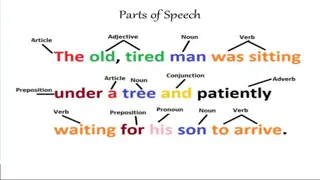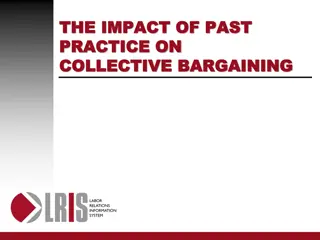Embracing Retrofuturism in Homebrewing: A Look Into the Past for Future Inspiration
Explore the fascinating world of retrofuturism and its influence on homebrewing with insights from Annie Johnson, an award-winning homebrewer. Discover the connections between history, modern interpretations, inspirations, and icons in brewing, and consider how this trend may shape the future of your brewing endeavors. Dive into the captivating blend of nostalgia and innovation that defines the retrofuturistic approach to crafting beer at home and beyond.
Download Presentation

Please find below an Image/Link to download the presentation.
The content on the website is provided AS IS for your information and personal use only. It may not be sold, licensed, or shared on other websites without obtaining consent from the author.If you encounter any issues during the download, it is possible that the publisher has removed the file from their server.
You are allowed to download the files provided on this website for personal or commercial use, subject to the condition that they are used lawfully. All files are the property of their respective owners.
The content on the website is provided AS IS for your information and personal use only. It may not be sold, licensed, or shared on other websites without obtaining consent from the author.
E N D
Presentation Transcript
RETROFURTURISM HomeBrewing Your Future with the Past
WHO AM I AND WHY AM I HERE?! ANNIE JOHNSON - 2013 AHA HOMEBREWER OF THE YEAR 2012 PILSNER URQUELL MASTERHOMEBREWER BREWMASTER/RECIPE R & D DISTILLER DEDICATED HOMEBREWER/KHALEESI SINCE 1998 AHA GOVERNING COMMITTEE MEMBER SINCE 2020 CHAIR - NATIONAL BLACK BREWERS ASSOCIATION ADVISORY COUNCIL 2023 AT-LARGE COLUMN CONTRIBUTOR CRAFT BEER & BREWING MAGAZINE
PICOBREW - WILLY WONKAS LABORATORY FOR BEER AND WHAT THE HELL HAPPENED?
RETROFUTURISM WHAT IS THAT? .is a trend in the creative arts showing the influence of depictions of the future produced in an earlier era. If "futurismis sometimes called a 'science' bent on anticipating what will come,retrofuturism is the remembering of that anticipation."
RETROFUTURISM History Modern Interpretations Inspirations Icons How does this pertain to me and my brewing? The state of homebrewing 2023 and beyond Q & A Bonus slides
HISTORY Ninkasi, Goddess of Brewing Mother Louise, alewife Brewster Josef Groll father of Pilsner
MODERN INTERPRETATIONS Breweries Homebrewers Equipment manufacturers Are they reinventing the wheel or just changing the tires? (tyres)
INSPIRATIONS Czech Pils Pilsner Urquell Saison Fantome Homebrewers (that s you!)
HOW DOES THIS PERTAIN TO ME AND MY BREWING? SHOULD I CARE?
QUESTIONS? Twitter: @buffalowing Instagram: smellsofhotdogs Email: midtownbrewer@gmail.com
Historical Triple Decoction Starting out with 50% distilled water can help most brewers get to the proper pH - the finished pH of the beer is about 4.6. Mash pH is about 5. Do NOT use calcium chloride - adjust with acid malt. Generally 1lbs per 5 gallon batch. MASH SCHEDULE The water grist ratio is 2.2-2.6 qts per pound of grain 1. Dough-in 99F and 15 min rest. It s OK if this goes longer than 15 so don t panic. DECOCTION MASHING SECRET SAUCE 2. Pull 1/3 of mash and heat to 150F and rest for 15-20 mins. 3. Boil decoction for 15 mins. Avoid scorching Go stir crazy think oatmeal boiling cauldron stirring action. 4. Add back to Mash raising temp to 125F - rest for 15-30 mins 5. Repeat steps 3 and 4 adding decoction back to raise the mash to 149F. Rest for 30 to 60 minutes 6. Repeat steps 3 and 4, adding back to raise to 170F. Rest for 10-15 minutes. Begin your sparge however you do it I am a batch sparger.
Water Chemistry German pilsners sulfate to chloride ratio 100ppm for sulfate and 85ppm for chloride. WATER German Pilsners greatly benefit from relatively high sulfate content in their water. John Palmer also published a water spreadsheet with guidelines for the ratio. A summary is below: 0-0.4: Too Malty 0.4-0.6: Very Malty 0.6-0.8: Malty 0.8-1.5: Balanced 1.5-2.0: Slightly Bitter 2-4: Bitter 4-9: Very bitter 9+: Too bitter! For a malty German Lager you would target something in the 0.4-0.6 range while keeping the overall sulfate levels low. Excessive levels of either sulfate or chloride can be harsh. You can add more chloride to your water by adding Calcium Chloride (CaCL2), and you can add sulfate by adding Gypsum (Calcium Sulfate or CaSO4). Go light on the water additions, however, as it does not take many grams to significantly change the water content. What s my local water look like and you can t always rely on water district s annual water report It s a weighted average of annual measurements so your results may vary Use a water calculator!
LAGER YEAST Pick a Lager Friendly Yeast High attenuation in the 70 78% range Med-high flocculation Reliable low ester producer Imperial Urkel Wyeast Pilsner Urquell H-Strain 2001-PC Fermentis Saflager w-34/70 WLP833 Bock lager Ask your pro brewers! Use a big fat FRESH yeast pitch























